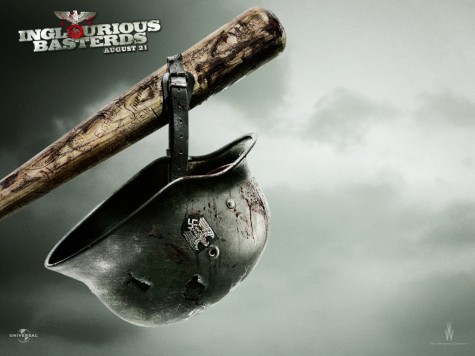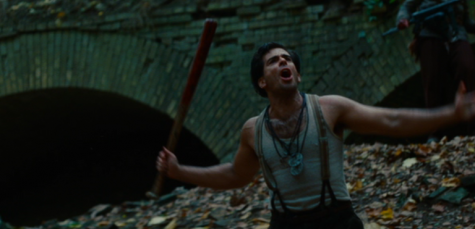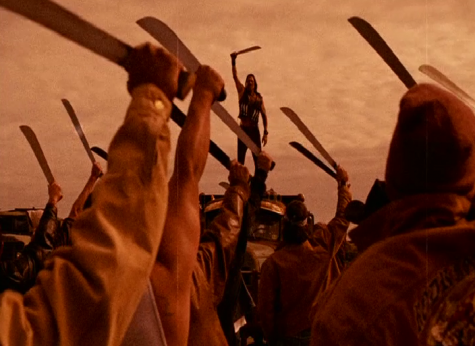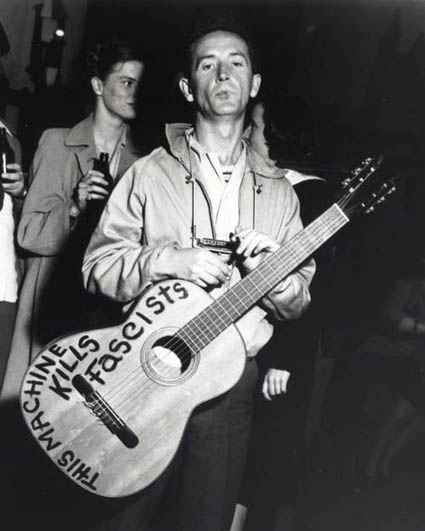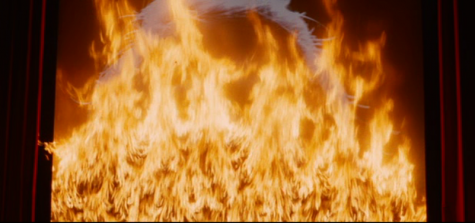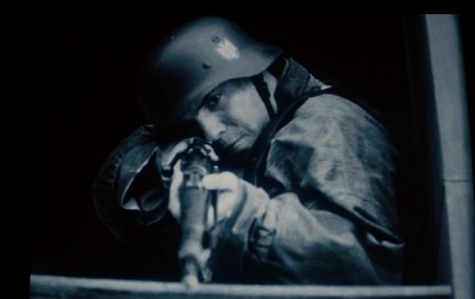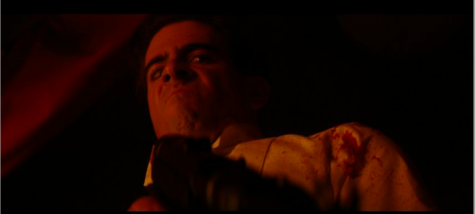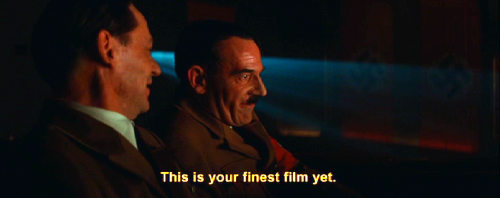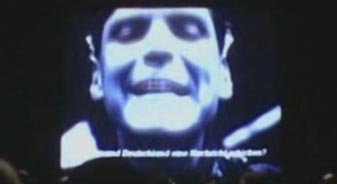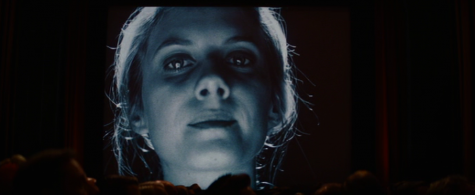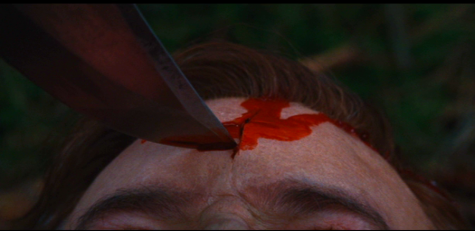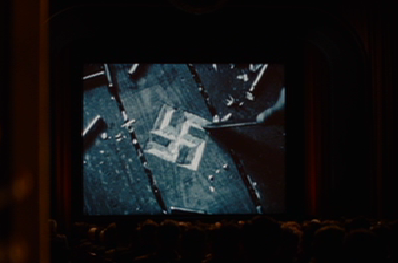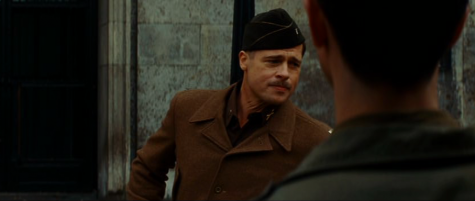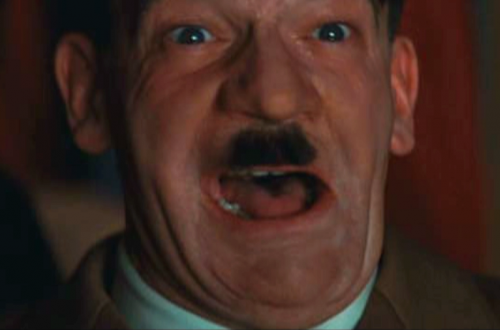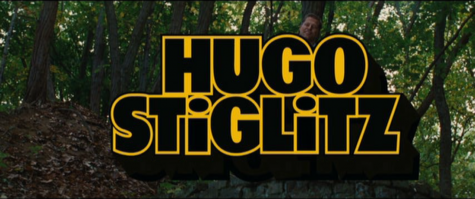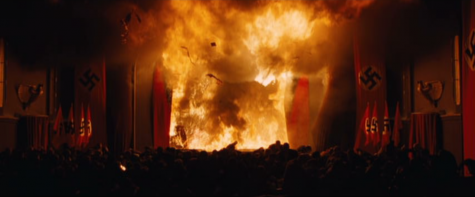Again, if you want to make sense of Inglourious Basterds, the questions are three: 1) Why take the triumphalist American history of WWII and make it even more triumphalist? 2) Why channel our perceptions of the 1940s via the 1970s? 3) And why commit mass murder upon the audience?
Here are some answers.
Tarantino is on record as saying that Inglourious Basterds is his “bunch-of- guys-on-a-mission film”—which would mean that it’s a version of the Dirty Dozen or The Guns of Navarone. Like almost everything else that Tarantino says in interviews, I think that sentence is a lie or a trick, which should become clear if you pause to consider how uninterested the movie is in the Basterds as Nazi hunters; we see them fighting Nazis almost not all. In fact the Shosanna plot is entirely separate from the Basterds plot and commands our attention every bit as intently. I’d like to say this isn’t really a men-on-a-mission movie; this is first and foremost a revenge movie; and you might say Why can’t it be both?—and yeah, sure, it’s both, but Tarantino has also decided to make nearly all the Basterds Jewish, which means that the revenge framework actually spills over from the Shosanna plot and colonizes the mission plot, too. It’s like the revenge movie is sucking the war movie into its field of gravity. Revenge is the common term that unites the two separate plots. Plus we know that Tarantino is deeply engaged with revenge movies, which were a staple of the ‘70s grindhouse circuit: Last House on the Left, Death Wish, Thriller: En Grym Film, I Spit On Your Grave, movies like that. Tarantino, in fact, has already made an epic revenge movie—that’s Kill Bill—so we can’t be all that surprised to see him returning to the form here.
OK—but if it’s a revenge movie, it’s an unusual one, because it has that oddly doubled narrative—not just one, but two revenge plots, unspooling side by side, and eventually converging, though without either revenge-party ever knowing about the other. And what you think is at stake in the revenge plot will depend in large part on whether you decide to emphasize the Basterds or Shosanna. So ask yourself which agent of revenge your heart favors.
If you emphasize the Basterds, then what really jumps out in the movie is the image of the tough-guy Jew. There’s a word that is common in Hebrew slang—and that Hebrew has bequeathed to Israeli English—and that’s frier, which means something like “pushover” or “sucker”—and it’s become one of the most distinctive Israeli insults. Nobody in Israel wants to be a frier; nobody wants to be pushover. My Israeli friends boast proudly that the country has the world’s highest incidence of fatal car crashes—and I don’t know if that’s true—but I do know that my friends brag about it, which tells me all I need to know—and the explanation they always give is that no Israeli in a car will ever back down, as in: yield the right of way. So all I want to say is that testosterone has become a very big deal in some corners of modern Jewish culture, for reasons that are not hard to reconstruct, and you could think of Inglourious Basterds as playing into this, by projecting an IDF-style masculinity back into the 1940s. And this curious notion obviously goes back to one of the classic, nagging questions in the historiography of the Second World War: Why didn’t European Jews resist the fascists in larger numbers? If Inglourious Basterds generates a compensatory fantasy, it is surely here; it’s not fantasizing about Americans winning the war; it’s fantasizing about Jews winning the war; and this is a fantasy it shares, roughly, with other tough-Jew movies, like Defiance, which features Daniel Craig as the Bärenjude. Those movies ask the question: What if the Warsaw Ghetto Uprising had spread? Or: What if there had already been a Mossad to counteract the SS?
Here’s the thing: If we focus instead on Shosanna, the movie will look rather different. Shosanna of course is also Jewish and also tough, so we can to some extent just fold her into that last point. But only to some extent. Why? Because the image of Eli Roth one handing a baseball bat is obviously an image of Jewish machismo, but the image of a burning movie theater is not.
What I mean is that Shosanna’s method of taking revenge is so different from the Basterds’ that it raises some new issues for us to think about. The blazing screen does not trigger the same set of real-world associations. Shosanna gets her revenge through film: She makes a movie passing judgment on the fascists, whom she then immolates in the flames of burning nitrate reels. So it’s not just that we see a filmmaker killing Nazis; it’s as though film itself were able to strike fascists dead. There are, I think, two different ways of clarifying what Tarantino is up to here.
1) One way to understand the film Shosanna makes and that we eventually see is as Tarantino’s homage to postwar French cinema—and to the kind of anti-fascist film that people like Buñuel were making even before the war. She makes a guerilla film, on the cheap: a technically rough, experimental, low-budget and anti-fascist film. It’s as though Tarantino were trying to engineer a history in which Buñuel never left for Mexico, or trying to backdate Godard by about fifteen years. The movie literally stages a showdown between fascist film and the anti-fascist film of the postwar Left. And this alone licenses us to say that Tarantino is deeply invested in the possibility of anti-fascist film. He has just given us, as hero, an anti-fascist director. Now would be the moment to be point out that he and his associates often seem to think that trash cinema is the continuation of anti-fascist film. If you’ve seen Robert Rodriguez’s Machete—or even just the fake trailer for the non-existent ‘70s drive-in movie that was the movie’s original incarnation—the point will not be lost on you: An army of illegal immigrants rises up against white bosses and politicians by repurposing as weapons the garden tools of a day laborer.
There’s plenty of precedence for this: One of the key blaxploitation movies is this film from 1976 called Brotherhood of Death, which is about a group of black Vietnam vets who return to the US and start using what the army taught them to fight the Klan. So we know that Tarantino and Rodriguez are fixated on grindhouse, but what they’re too cool to say out loud is that they basically think of grindhouse as a people’s cinema—crude and insurgent—a precious collection of movies about black people taking out the Klan and women turning the knife back against the men who attack them and kung fu masters sticking up for Native Americans.
2) What I’m saying, basically, is that Quentin Tarantino is our Woody Guthrie; he is the Woody Guthrie of mondo and the midnight movie. That is not a joke. The most famous picture of Woody Guthrie gives the viewer a clear look at the folk-singer’s guitar, across which is scrawled: “This machine kills fascists.”
We need to think hard about the fantasy that is communicated by that sentence—because we’re trying to make sense of this image—
—and that sentence provides the second important clarification. Woody Guthrie didn’t just want to sing about justice; he didn’t just want to “inspire his listeners” or get them to raise their voices in the spirit of peace or whatever it is that we usually think folk singers do; he was trying to imagine a music so powerful that it would actually bring justice into the world; he wanted to strum justice into existence; wanted an art that wouldn’t just be in the service of revolution, but that would itself be the completed revolutionary act. And that’s exactly what Tarantino gives us at the end of the movie: “This movie screen kills fascists.” That fantasy—the fantasy of a fully revolutionary art—turns out to be very old. As early in the 1590s, some English poets were trying to write plays that not only depicted revenge, but actually achieved it; they were trying to imagine plays that could actually kill corrupt courtiers and oppressive princes, as though blank verse could actually draw blood. Or if we flash-forward to 1969, we will find Amiri Baraka writing these lines, in a poem called “Black Arts”:
We want ‘poems that kill.’
Assassin poems, Poems that shoot
guns. Poems that wrestle cops into alleys
and take their weapons leaving them dead.
What we can say now is that Tarantino is paying homage to the history of anti-fascist film; and he is also trying to imagine a movie that could not only describe justice but actually achieve it. And of course, we need to put those points together and say that he is trying to imagine the perfect anti-fascist film—a film so righteously anti-fascist that it literally levels any fascist who wanders into its projected light; a film that fascists cannot watch; a film that turns fascists to dust. So maybe now we can say, or begin to say, explain why Tarantino has rewritten the history of 1944. Inglourious Basterds wants to give credit for the victory in World War II to someone other than the US and Soviet armies; to nominate, as the virtual heroes of some secret history, badass Jews and cinema itself. It’s an extraordinary idea.
…except I think that’s it all wrong. None of what I’ve just written actually works; or rather, the movie does in fact put in play the two fantasies I’ve been describing—the fantasy of a muscular Judaism and the fantasy of the perfect anti-fascist film—but then it takes them back—or at least makes them harder to occupy. First it gets us to share those fantasies and then it starts calling the fantasies into question. There are two good reasons to think this.
The first I will mention only briefly and ask you to think about on your own time. One of the plain ways we have to describe who Shosanna is and what she does in this movie is to say that she is a suicide bomber. If you want to get fancy, you will say that she is a twentieth-century Samson, pulling the roof down on the heads of the Jews’ celebrating enemies, but if you go back and read the Samson story, you’ll be forced to conclude before long that he, too, was a suicide bomber, so it’s really the same point anyway. At that point we will recall that there was a bomb attack on a movie theater in northern India in 2007; another in Mumbai during the wave of coordinated attacks in 2009; an especially bad movie theater bombing in Algeria in 1998; and so on. The movie undoubtedly produces an image of a heroic Judaism, but only at the cost of letting it mutate visibly into one of its putative opposites, which is the Muslim terrorist.
That’s one of the big surprises hidden away in the movie’s fantasies. The second is easiest to communicate through a series of paired images:
1)
2)
“You know something, Utivich? I think this might just be my masterpiece.”
3)
Here’s my gloss on that sequence. 1) We see a Nazi soldier, shot from below, mowing down an improbable number of the gathered enemy. Then we see an American soldier doing the same thing—and in a similar shot. 2) We see an American soldier mutilating an enemy officer and calling it his masterpiece; and we see Hitler telling Goebbels that he has made his masterpiece. 3) We see a fascist turn to the camera in black-and-white and address the audience directly, speaking English for the first time. And then we see the anti-fascist turn to the camera in black-and-white and address the audience directly, speaking English for the first time. We can see what this adds up to. Tarantino has built in unmistakable visual rhymes between the fascist movie and its putatively anti-fascist alternatives. Just to be clear: There are three movies in play here—the movie we are watching, Tarantino’s movie; the fascist movie; and Shosanna’s anti-fascist movie. So two anti-fascist movies and a fascist movie. And the point is that each of the two anti-fascist movies plainly, demonstrably resembles the fascist movie. Everything in the movie starts bleeding into fascism. Two more pairings, to coax over the disbelieving:
4)
An American soldier carves a swastika with a Bowie knife.
A German soldier carves a swastika with a Bowie knife.
5)
“Our battle plan will be that of an Apache resistance.”
But of course what’s true in miniature is also true globally: The fascists are watching a patriotic war movie about the grotesquely exaggerated exploits of a national hero. And you can’t even get that sentence out of your mouth without realizing that, yes, we too have been watching a patriotic war movie about the grotesquely exaggerated exploits of our national heroes. The anti-fascist movie we thought we were watching outs itself as fascism’s secret twin. There’s a lot to say here, but the short version is that I think we are in the presence of a filmmaker losing his confidence in grindhouse as a people’s cinema and trying to find a way to make trash cinema yield a critique of itself instead. This all comes down to the audience: What I find most striking about the shots of the audience in this movie is how attentive they are to the immediate effects of screen violence upon a group of viewers. Let me put it this way: I saw the movie twice in a theater, and each time I saw it, when the movie screen went up in flames, someone in the room clapped—not a full-palmed ovation, just three fingers of one hand in the heel of the other, the quick little rat-a-tat of a person overcome by excitement. But then of course Inglourious Basterds, in four or five different shots, shows a movie audience of fascists whoop-whooping to a blood orgy. Let me come at it from another angle. In the movie, we see one audience member laughing. I’m guessing many people were laughing when you saw the movie; you might have laughed yourself. This gets at something important, because as long as Tarantino has been making movies, high-minded critics have fretted that he makes violence entirely too pleasurable: Michael Madsen slices off a man’s ear, and the audience are bopping in their seats because “Stuck in the Middle With You” is chiming on the soundtrack. You grin as Bruce Willis trades up from hammer to baseball bat to chainsaw to samurai sword. The only movie I have ever walked out on because of the audience was the Coen brothers’ Blood Simple—close cousin to Reservoir Dogs or Pulp Fiction—and I left it because the rest of my row was cracking up while Dan Hedaya was getting buried alive, shrieking keen through mouthfuls of dirt. So how dare anyone make death funny? You have to imagine that Tarantino has always shrugged off that accusation; you can call up YouTube videos of him shrugging it off in interviews—except now he has conceded it. And we know he has conceded it because here’s the one person we see laughing at the violence:
There is only one person laughing, and it is mother-loving Hitler. That is the sight of a filmmaker profoundly alienated from his own fans, wigging out at the ability of the movies he most loves to produce in us a quasi-fascist joy in violence. So why does Tarantino hate us so much? He hates us for liking his movies the way we do; he hates us because he can so easily bring us round to enjoying the sight of people being gathered into a closed space so that they can be exterminated. He hates you for how easily you can be pushed into the Nazi position, as long as the people getting killed are themselves Nazis. He hates you because you are the fascist and you don’t even know it. And he proposes the self-consuming grindhouse solution to this grindhouse dilemma, which is that people like you have to die. You will uphold your death sentence with your applause.

